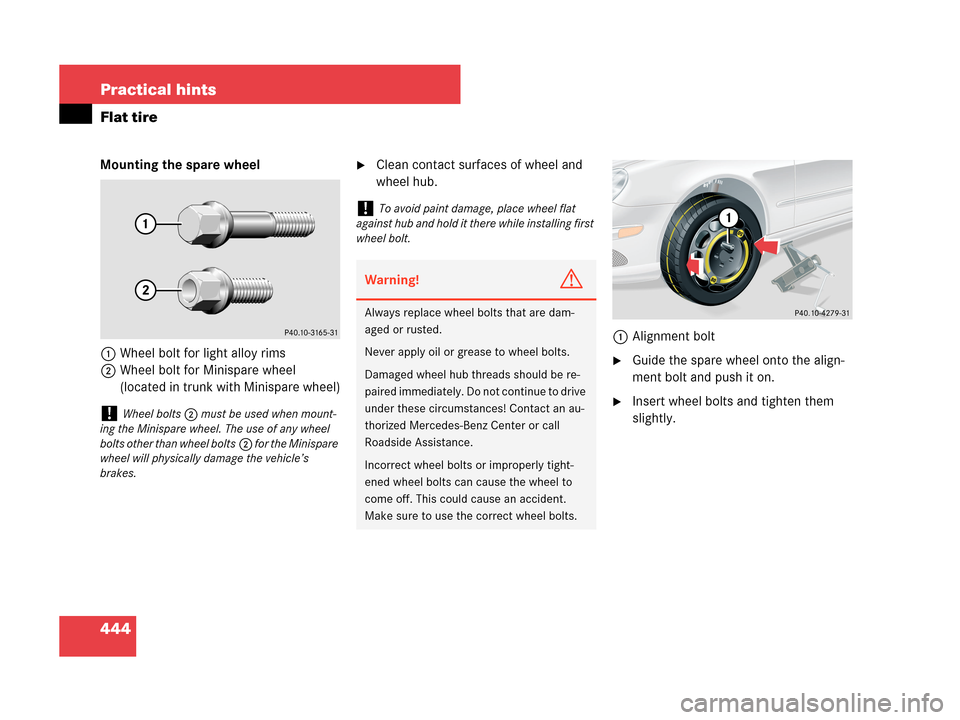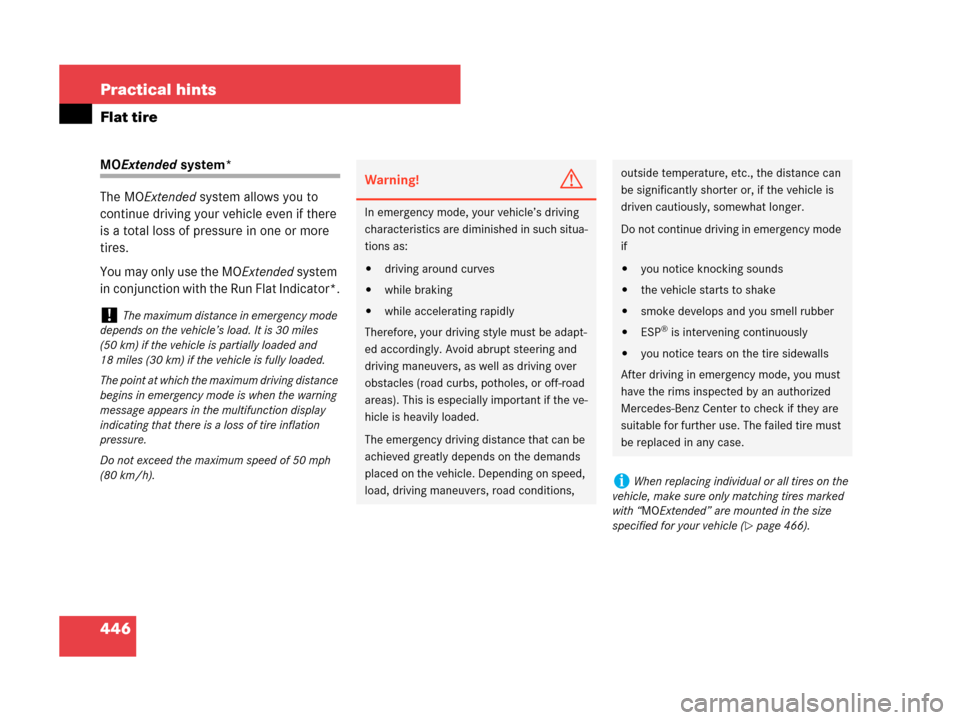Page 365 of 505

364 Operation
Vehicle care
Seat belts
�Only use clear, lukewarm water and
soap.
Upholstery
Using aftermarket seat covers or wearing
clothing that have the tendency to give off
coloring (e.g. when wet, etc.) may cause
the upholstery to become permanently
discolored. By lining the seats with a
proper intermediate cover,
contact-discoloration will be prevented.Leather upholstery
Please note that leather upholstery is a
natural product and is therefore subject to
a natural aging process. Leather
upholstery may also react to certain
ambient influences such as high humidity
or high temperature by showing wrinkles
for example.
�Wipe leather upholstery with a damp
cloth and dry thoroughly or clean with
Mercedes-Benz approved Leather
Care.Exercise particular care when cleaning
perforated leather as its underside should
not become wet.
Wood trims
�Dampen cloth using water and use
damp cloth to clean wood trims in your
vehicle.
!The seat belts must not be treated with
chemical cleaning agents. Do not dry the seat
belts at temperatures above 176°F (80°C) or in
direct sunlight.
Warning!G
Do not bleach or dye seat belts as this may
severely weaken them. In a crash they may
not be able to provide adequate protection.
Warning!G
Only use seat or head restraint covers which
have been tested and approved by
Mercedes-Benz for your vehicle model.
Using other seat or head restraint covers
may interfere with or prevent the activation
of the active head restraints. Contact an
authorized Mercedes-Benz Center for
availability.
!Wipe with light pressure to avoid damage to
the upholstery.
!Do not use solvents like tar remover or
wheel cleaner nor polishes or waxes as these
may be abrasive.
Page 410 of 505
409 Practical hints
Where will I find...?
In case of a flat tire, you may temporarily
use the Minispare wheel when observing
the following restrictions:
�Do not exceed a vehicle speed of
50 mph (80 km/h).
�Drive to the nearest tire repair facility
to have the flat tire repaired or
replaced as appropriate.
�Do not operate vehicle with more than
one Minispare wheel mounted.
For more information, see “Rims and tires”
(
�page 466).
Spare wheel bolts
The spare wheel bolts are fixed at the
Minispare wheel.
1Wheel bolt for light alloy rims
2Wheel bolt for Minispare wheel
(located in trunk with spare wheel)!Wheel bolts2 must be used when mount-
ing the Minispare wheel. The use of any wheel
bolts other than wheel bolts2 for the Minispare
wheel will physically damage the vehicle’s
brakes.
Warning!G
Make sure to use the original length wheel
bolts when remounting the original wheel
after it has been repaired.
Page 445 of 505

444 Practical hints
Flat tire
Mounting the spare wheel
1Wheel bolt for light alloy rims
2Wheel bolt for Minispare wheel
(located in trunk with Minispare wheel)�Clean contact surfaces of wheel and
wheel hub.
1Alignment bolt
�Guide the spare wheel onto the align-
ment bolt and push it on.
�Insert wheel bolts and tighten them
slightly.!Wheel bolts2 must be used when mount-
ing the Minispare wheel. The use of any wheel
bolts other than wheel bolts2 for the Minispare
wheel will physically damage the vehicle’s
brakes.
!To avoid paint damage, place wheel flat
against hub and hold it there while installing first
wheel bolt.
Warning!G
Always replace wheel bolts that are dam-
aged or rusted.
Never apply oil or grease to wheel bolts.
Damaged wheel hub threads should be re-
paired immediately. Do not continue to drive
under these circumstances! Contact an au-
thorized Mercedes-Benz Center or call
Roadside Assistance.
Incorrect wheel bolts or improperly tight-
ened wheel bolts can cause the wheel to
come off. This could cause an accident.
Make sure to use the correct wheel bolts.
Page 447 of 505

446 Practical hints
Flat tire
MOExtended system*
The MOExtended system allows you to
continue driving your vehicle even if there
is a total loss of pressure in one or more
tires.
You may only use the MOExtended system
in conjunction with the Run Flat Indicator*.
!The maximum distance in emergency mode
depends on the vehicle’s load. It is 30 miles
(50 km) if the vehicle is partially loaded and
18 miles (30 km) if the vehicle is fully loaded.
The point at which the maximum driving distance
begins in emergency mode is when the warning
message appears in the multifunction display
indicating that there is a loss of tire inflation
pressure.
Do not exceed the maximum speed of 50 mph
(80 km/h).
Warning!G
In emergency mode, your vehicle’s driving
characteristics are diminished in such situa-
tions as:
�driving around curves
�while braking
�while accelerating rapidly
Therefore, your driving style must be adapt-
ed accordingly. Avoid abrupt steering and
driving maneuvers, as well as driving over
obstacles (road curbs, potholes, or off-road
areas). This is especially important if the ve-
hicle is heavily loaded.
The emergency driving distance that can be
achieved greatly depends on the demands
placed on the vehicle. Depending on speed,
load, driving maneuvers, road conditions,
outside temperature, etc., the distance can
be significantly shorter or, if the vehicle is
driven cautiously, somewhat longer.
Do not continue driving in emergency mode
if
�you notice knocking sounds
�the vehicle starts to shake
�smoke develops and you smell rubber
�ESP® is intervening continuously
�you notice tears on the tire sidewalls
After driving in emergency mode, you must
have the rims inspected by an authorized
Mercedes-Benz Center to check if they are
suitable for further use. The failed tire must
be replaced in any case.
iWhen replacing individual or all tires on the
vehicle, make sure only matching tires marked
with “MOExtended” are mounted in the size
specified for your vehicle (
�page 466).
Page 460 of 505
459 Technical data
Parts service
Warranty coverage
Identification labels
Layout of poly-V-belt drive
Engine
Rims and tires
Electrical system
Main dimensions and weights
Fuels, coolants, lubricants, etc.
Page 467 of 505

466 Technical data
Rims and tires
!Only use tires which have been tested and
approved by Mercedes-Benz. Tires approved by
Mercedes-Benz are developed to provide best
possible performance in conjunction with the
driving safety systems on your vehicle such as
ABS or ESP
®. Tires specially developed for your
vehicle and tested and approved by Mer-
cedes-Benz can be identified by finding the fol-
lowing on the tire’s sidewall:
�MO = Mercedes-Benz Original equipment
tires
AMG vehicles:
Does not apply to all approved tires on AMG
vehicles. For information on tested and ap-
proved tires for AMG vehicles, contact an au-
thorized Mercedes-Benz Center.
�MOE = Mercedes-Benz Original Extended
(tires with limited run-flat characteristics)
original equipment tires. Using tires other
than those approved by Mercedes-Benz may
result in damage that is not covered by the
Mercedes-Benz Limited Warranty.
iFor information on driving with MOExtended
tires, see “MOExtended system*” (
�page 336).
!Using tires other than those approved by
Mercedes-Benz can have detrimental effects,
such as
�poor handling characteristics
�increased noise
�increased fuel consumption
Moreover, tires and rims not approved by
Mercedes-Benz may, under load, exhibit dimen-
sional variations and different tire deformation
characteristics that could cause them to come
into contact with the vehicle body or axle parts.
Damage to the tires or the vehicle may be the
result.
iFurther information on tires and rims is
available at any authorized Mercedes-Benz Cen-
ter. A placard with the recommended tire infla-
tion pressures is located on the driver’s door
B-pillar. Some vehicles may have supplemental
tire inflation pressure information for driving at
high speeds (
�page 332) or for vehicle loads
less than the maximum loaded vehicle condition
(
�page 331).If such information is provided, it can be found
on the placard located on the inside of the fuel
filler flap. The tire inflation pressure should be
checked regularly and should only be adjusted
on cold tires. Follow tire manufacturer’s mainte-
nance recommendation included with vehicle.
iThe following pages also list the approved
wheel rim and tire sizes for equipping your vehi-
cles with winter tires. Winter tires are not avail-
able as standard or optional factory equipment,
but can be purchased from an authorized
Mercedes-Benz Center.
Depending on vehicle model and the standard or
optional factory-equipped wheel rim/tire config-
uration on your vehicle (Appearance Package,
Sport Package etc.), equipping your vehicle with
winter tires approved for your vehicle model may
also require the purchase of two or four wheel
rims of the recommended size for use with these
winter tires. See an authorized Mercedes-Benz
Center for more information.
Page 468 of 505
467 Technical data
Rims and tires
Same size tires
ModelCLK 350CLK 550
Rims (light alloy)7.5 J x 17 H27.5 J x 17 H2
Wheel offset1.42 in (36 mm)1.45 in (37 mm)
Winter tires1,3
1Radial-ply tires
225/45 R17 91 H M+S.225/45 R17 91 H M+S.
Winter tires1,2,3
2Must be used in conjunction with Run Flat Indicator* only. 3Not available as factory equipment.
225/45 R17 91 H M+S.MOExtended225/45 R17 91 H M+S.MOExtended
ModelCLK 63 AMG
Rims (light alloy)8 J x 18 H2
Wheel offset1.34 in (34 mm)
Winter tires1,2,3225/40 R18 92 V XL (Extra Load) M+S.
1Radial-ply tires2Not available as factory equipment.3For use with snow chains contact an authorized Mercedes-Benz Center.
Page 469 of 505
468 Technical data
Rims and tires
Mixed size tires
ModelCLK 350CLK 550CLK 63 AMG
Front axle:
Rims (light alloy)7.5 J x 17 H27.5 J x 17 H28 J x 18 H2
Wheel offset1.42 in (36 mm)1.46 in (37 mm)1.34 in (34 mm)
Summer tires1
1Radial-ply tires
225/45 R17 91W225/45 ZR17 91W225/40 ZR18 92Y XL (Extra Load)
Summer tires*1,2
2Must be used in conjunction with Run Flat Indicator* only.
225/45 R17 91W MOExtended225/45 R17 91W MOExtended -
Rear axle:
Rims (light alloy)8.5 J x17 H28.5 J x17 H28.5 J x18 H2
Wheel offset1.18 in (30 mm)1.18 in (30 mm)1.18 in (30 mm)
Summer tires1,3
3Must not be used with snow chains.
245/40 R17 91W245/40 ZR17 91W255/35 ZR18 94Y XL (Extra Load)
Summer tires*1,2,3245/40 R17 91W MOExtended245/40 R17 91W MOExtended -